January 2006 LIP of the Month
Corresponds to part of event #31 in LIP record database.
The Karoo Volcanic Province in Antarctica: Identifying Mantle Sources
Teal Riley
British Antarctic Survey, Natural Environment Research Council, High Cross, Madingley Road, Cambridge, CB3 0ET, UK
e-mail: t.riley@bas.ac.uk
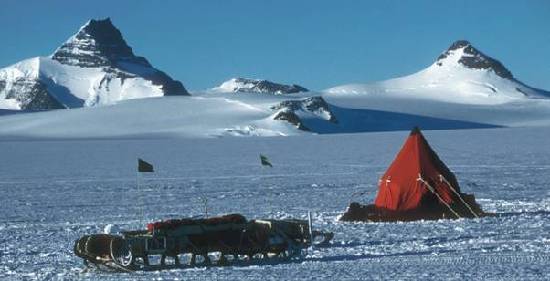
Field camp at Istind, western Dronning Maud Land
A suite of dolerite dykes from the Ahlmannryggen region of western Dronning Maud Land (Antarctica) form part of the much more extensive Karoo igneous province of southern Africa. The dyke compositions include both low- and high-Ti magma types, including picrites and ferropicrites. New 40Ar/39Ar age determinations for the Ahlmannryggen intrusions indicate two ages of emplacement at ~178 and ~190 Ma. Four geochemical groups of dykes have been identified in the Ahlmannryggen region based on analyses of ~ 60 dykes. The groups are defined on the basis of whole-rock TiO2 and Zr contents, and reinforced by rare earth element, 87Sr/86Sr and 143Nd/144Nd isotope data. Group 1 were intruded at ~190 Ma and have low TiO2 and Zr contents and a significant Archean crustal component, but also evidence of hydrothermal alteration. Group 2 dykes were intruded at ~178 Ma and have low-moderate TiO2 and Zr contents and are interpreted to be the result of mixing of melts derived from an isotopically depleted source with small melt fractions of an enriched lithospheric mantle source. Group 3 dyke were intruded at ~190 Ma and form the most distinct magma group; these are largely picritic with superficially MORB-like chemistry (flat REE patterns, 87Sr/86Sri ~ 0.7035, eNdi ~ 9). However, they have very high TiO2 (~ 4 wt%) and Zr (~500 ppm) contents, which is not consistent with melting of MORB-source mantle. The Group 3 magmas are inferred to be derived by partial melting of a strongly depleted mantle source in the garnet stability field. This group includes several high Mg-Fe dykes (ferropicrites), which are interpreted as high temperature melts. Some Group 3 dykes also show evidence of contamination by continental crust. Group 4 dykes are low-K picrites intruded at ~178 Ma; they have very high TiO2-Zr contents and are the most enriched magma group of the Karoo-Antarctic province with OIB-like chemistry. Dykes of Group 1 and Group 3 are sub-parallel (ENE-WSW) and both groups were emplaced at ~190 Ma in response to the same regional stress field, which had changed by ~178 Ma, when Group 2 and Group 4 dykes were intruded along a dominantly NNE-SSW strike.
Introduction
The lavas and dykes of western Dronning Maud Land, Antarctica, are generally considered as an extension of the Karoo large igneous province of southern Africa (Harris et al., 1991; Luttinen et al., 1998). The regional dolerite dykes of the Ahlmannryggen area (Fig. 1) have previously been described by Harris et al. (1991), who made comparisons with the composition of basalt lavas from the Kirwanveggen area further to the south (Harris et al., 1990), and also to the high-Ti basalts of the Karoo province (Duncan et al., 1984). This study extends the work of Harris et al. (1991) by providing a full geochemical and isotopic data set over a broader geographic area, therefore allowing comparisons to be made with more recent data on the Karoo igneous province of southern Africa (e.g. Sweeney et al., 1994), and elsewhere in East Antarctica (e.g. Luttinen & Furnes, 2000).
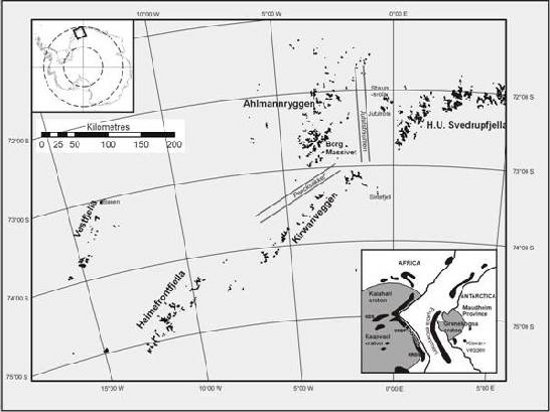
Figure 1: Location map of rock outcrops in western Dronning Maud Land (Antarctica) from Vestijella to H.U. Svedruptjella. The inset is a pre-break-up Gondwana reconstruction of Africa and Antarctica showing the extent of the Kaapvaal-Grunehogna craton and the outcrop of Early Middle Jurassic age Karoo igneous rocks.
Geological Setting
Basaltic lavas and minor intrusions of Jurassic age crop out at several localities in western Dronning Maud Land, Antarctica (Fig. 1). Both flood basalts and dykes are exposed at Vestfjella, Heimefrontfjella and Kirwanveggen, whilst only dykes are exposed in the Ahlmannryggen, Mannefallknausane and H.U. Svedrupfjella areas (Fig. 1). In the Kirwanveggen, the lavas are sub horizontal and form a succession up to 300m in thickness (Harris et al., 1990). The Kirwanveggen lavas overlie clastic sediments of the Amelang Plateau Formation; these sedimentary rocks overlie Proterozoic gneisses basement of the Svedrupfjella Group. Locally, the sedimentary succession is absent and the lavas directly overlie the gneisses. Two of these lava flows have been dated by 40Ar/39Ar geochronology (Duncan et al., 1997), with Middle Jurassic ages of 180.6 ± 0.6 and 182.8 ± 0.6 Ma. In Vestfjella, the thickness of the lava pile exceeds 900 m in the north and 400 m in the south (Luttinen & Furnes, 2000). The lava pile is cut by dolerite dykes and sills and, at Muren and Utpostane (Fig. 1), by gabbro intrusions (Vuori & Luttinen, 2003), which have been dated at 177.0 ± 0.5 Ma (40Ar/39Ar on plagioclase; Zhang et al., 2003). The age of the Vestfjella lavas is poorly constrained, although plagioclase K–Ar ages of ~180 Ma for the north Vestfjella lavas (Peters et al., 1991) provide the best age estimate available and correspond to the age of the Kirwanveggen lavas (Duncan et al., 1997).
The basement of western Dronning Maud Land is divided into two major domains. Prior to the Mesozoic break-up of Gondwana, the Archean Grunehogna craton (Fig. 1) is presumed to have been part of the Kaapvaal craton (Groenewald et al., 1995). The craton is bounded to the east and southeast by the Mesoproterozoic Maud Belt, the Antarctic extension of the Natal Belt of Africa (Jacobs et al., 1993). The exact position of the Archean–Proterozoic lithospheric terrane boundary is not firmly established, but, on the basis of gravity and aeromagnetic data, it has been interpreted to be located between 72°–73° S, i.e. close to north Vestfjella (Luttinen & Furnes, 2000).
The minor intrusions of the Ahlmannryggen area intrude Neoproterozoic age rocks of the Ritscherflya Supergroup, which cover the entire Ahlmannryggen and Borg Massivet regions (Fig. 1). The Ritscherflya Supergroup, which overlies Archean (2.8 – 3.0 Ga) basement, consists of relatively undeformed sedimentary and volcanogenic rocks of the Ahlmannryggen and Jutulstraumen groups (Wolmarans & Kent, 1982), which have been intruded extensively by massive tholeiitic sills and dykes of the Borgmasssivet Intrusions (Wolmarans & Kent, 1982). Wolmarans & Kent (1982) reported a Rb-Sr whole rock isochron age of 1073 ± 40 Ma based on seven mafic sills from the Ahlmannryggen, therefore the Borgmassivet Intrusions could be coeval with the Umkondo large igneous province of southern Africa (1.1 Ga; Hanson et al. 1998). This date is close to the inferred lithification age of the Ritscherflya Supergroup sedimentary rocks (1085 ± 27 Ma; Moyes et al. 1995) and therefore supports the field observations of Krynauw et al. (1988) and Curtis & Riley (2003) that the Borgmassivet Intrusions were emplaced into wet, partially lithified sediments.
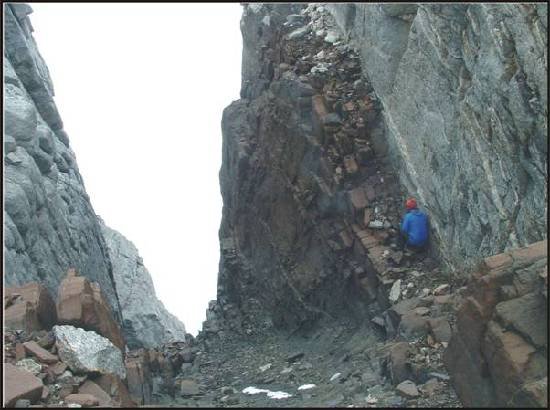
16 m wide dolerite dyke from northwest Jutulrora, Dronning Maud Land
Geochronology
Previous work
Very few reliable ages have been published for the minor intrusions of western Dronning Maud Land. Mesozoic ages have been reported by Wolmarans & Kent (1982) who dated an olivine-bearing dolerite dyke from Nils Jorgennutane (Fig. 1) at 192 ± 8 Ma (K-Ar whole rock), whilst Watters & Rex (K-Ar unpublished data in Harris et al., 1991) have reported ages in the range 190 – 200 Ma. 40Ar/39Ar geochronology on plagioclase mineral separates by Brewer et al. (1996) indicated two episodes of mafic magmatism, at 182.4 ± 1.9 Ma (dolerite sill) and a younger episode at 172.4 ± 2.1 Ma (basalt lava), from the nearby Heimefrontfjella area (Fig. 1). The older episode of magmatism has been confirmed by Duncan et al. (1997) who carried out an 40Ar/39Ar study on basaltic lavas from Kirwanveggen (Fig. 1), which yielded plateau ages of 180.4 ± 0.6 and 182.6 ± 0.6 Ma, coincident with the main Karoo volcanism of southern Africa (Riley & Knight, 2001). Zhang et al. (2003) have recently completed a detailed 40Ar/39Ar study on a variety of basaltic rocks from the Vestfjella region (Fig. 1) of western Dronning Maud Land, which display a broad range of Jurassic ages. They reported ages of 177.0 ± 0.5 Ma for the Utpostane gabbro and 176.6 ± 0.5 Ma for a dolerite dyke from the Kirwanveggen, whilst a dolerite dyke from Basen (Fig. 1) was dated at ~193 Ma. 40Ar/39Ar geochronology data reported by Grantham (1996) for the Straumsvola and Tvora (Fig. 1) alkaline plutons (Harris & Grantham, 1993) from western Dronning Maud Land indicate intrusion ages in the range 178 – 182 Ma, whilst Harris et al. (2002) gave an age of ~180 Ma for the nearby Sistefjell syenite (Fig. 1).
This study
Two dates which are repeated throughout this study are a pre-Karoo volcanism (182 Ma) age of ~190 Ma and a post-Karoo volcanism age of ~178 Ma. The 178 Ma age is in close agreement with recent age data from the Okavango dyke swarm (Botswana), which yield 40Ar/39Ar (whole rock and plagioclase) plateau ages in the range 178.4 ± 1.1 to 180.9 ± 1.3 Ma (Elburg & Goldberg, 2000; Le Gall et al., 2002; Jourdan et al., 2004a), with a magmatic peak at ~178 Ma. Zhang et al. (2003) also reported ages of ~177 Ma for lavas, dykes and gabbros from Vestfjella and Kirwanveggen, western Dronning Maud Land (Fig. 1). The study by Zhang et al. (2003) highlighted similar problems to those of this study, and they noted that the majority of their plagioclase samples yielded discordant age spectra, which they interpreted as reflecting alteration, excess 40Ar and recoil redistribution.
The pre-Karoo ages of ~190 Ma are problematic because dates of ~10 Myr older than the main Karoo peak at 182 Ma have not been considered as viable crystallisation ages before. Zhang et al. (2003) dated plagioclase from a Vestfjella dolerite dyke at 193.0 Ma, but discounted this date as discordant. Jourdan et al. (2004a) also published an integrated age of 191.5 ± 8.4 Ma for a dyke from the Okavango swarm using their “speedy” step- heating experiments. Several of the Ahlmannryggen dykes yield ages of ~190 Ma, although there is a scientific case for some of them also to be interpreted as ~178 Ma if different steps at different temperatures are used for calculation, or if an isochron/errorchron age is adopted instead of a plateau age.
Geochemistry
In common with other studies of Mesozoic and older flood basalt provinces we primarily use the incompatible high field strength elements (HFSE; Ti, Zr, Y, Nb) as discriminants between different magma types. These elements are considered largely immobile during low temperature alteration processes and ratios between them are not significantly modified by moderate amounts of fractional crystallisation or susceptible to variations in the degree of partial melting (e.g. Luttinen & Furnes, 2000). Zr can be iused as an effective index of differentiation in magmas which do not crystallise zircon.
Zr vs. TiO2 (Fig. 2) for all the data from the Ahlmannryggen dykes and elsewhere in the Karoo allow us to differentiate a number of distinct dyke groups. Based on the Zr vs. TiO2 plot (Fig. 6a) four geochemical groups can be identified from the Ahlmannryggen data set. These four geochemical groups are subsequently referred to as Groups 1 – 4; Group 1- Low Ti-Zr-Y: TiO2 (<2.3 wt%), Zr (<165 ppm), Nb (<10 ppm) and Y (<30 ppm); Group 2: Low Ti-Zr group: TiO2 <2.6 wt%, Zr <200 ppm, Nb >10 ppm and Y >33 ppm; Group 3: High Ti-Zr: TiO2 (>3 wt%), high Zr (200 – 400 ppm); Group 4: Very high Ti-Zr; TiO2 (> 4 wt%) and Zr (> 400 ppm) group.
When the data for the four dyke groups are plotted against MgO (wt%) as an index of differentiation it is clear that samples from Groups 1 and 2 are typically the most differentiated with MgO contents ~ 6 wt%. Whereas samples from Groups 3 and 4 have more than 7 wt% MgO. Ni is strongly correlated with MgO suggesting olivine control during magmatic differentiation. Al2O3 increases sharply as MgO decreases suggesting that plagioclase fractionation is not important until MgO contents fall below ~6 wt%. Groups 1 and 2 are distinctive in showing wide ranges of variation in SiO2, Fe2O3, CaO, Al2O3 and Y at constant MgO contents.
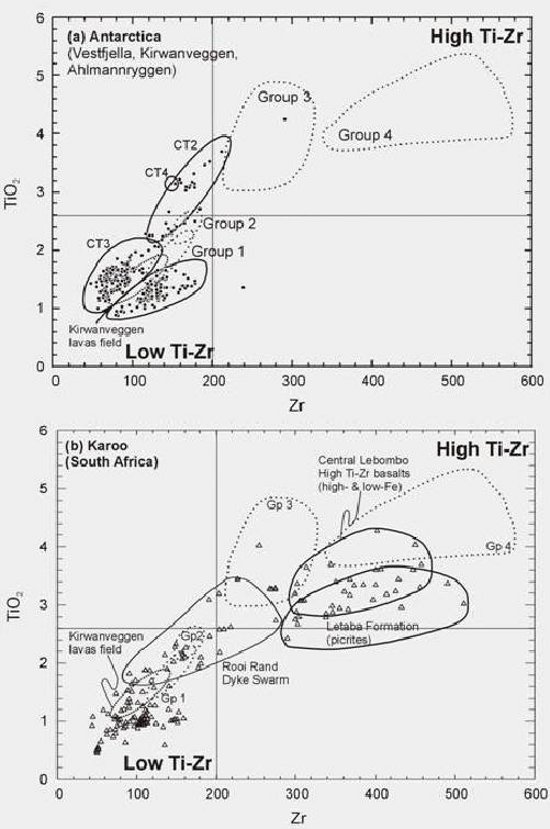
Figure 2: TiO2 and Zr are considered immobile during alteration processes and provide useful elements for characterizing magma groups. The Ahlmannryggen dyke suites are divided into four separate groups, which include some of the highest Ti-Zr values reported in the Karoo. They are compared to data from South Africa and overlap in part with the High Ti-Zr field from the Lebombo and also the Letaba picrites. Many of the Karoo volcanic rocks are low-Ti tholeiites.
Group 1
Only six of the minor intrusions analysed from the Ahlmannryggen fall into the low TiO2-Zr Group 1. The six samples have TiO2 contents in the range 1.5 – 2.3 wt% and Zr contents of 122 – 164 ppm. These dykes overlap in part, with the field of Kirwanveggen lavas (Harris et al., 1990), which are Middle Jurassic in age (Duncan et al., 1997) and they also partially overlap with the CT1 Vestfjella lavas of Luttinen & Furnes (2000). Group 1 rocks have SiO2 contents in the range 49.3 – 55.7 wt%. They typically have low mg-numbers (~50; mg-number = (Mg/(Mg+Fe2+)*100); FeO = Fe2O3/1.15). Cr and Ni contents are varied, with Cr ranging from 75 to 708 ppm and Ni, 81 to 318 ppm. Group 1 rocks are light rare earth element (LREE) enriched with (La/Yb) N ranging from 0.5 to 4.9 and LREE contents up to 25 times chondrite (Fig. 3).
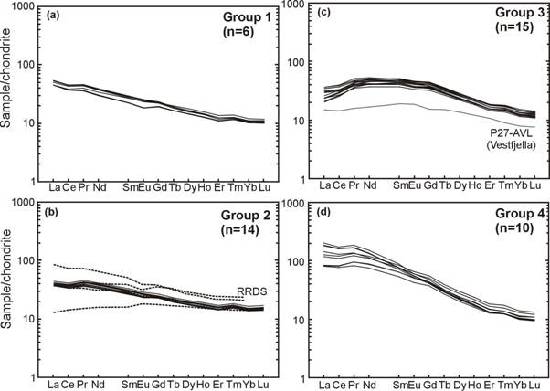
Figure 3: Chondrite normalised REE patterns for the four dyke groups. RRDS: Rooi Rand dyke swarm.
Almost all samples have relatively flat mid to heavy chondrite normalised REE patterns with (Sm/Lu)N ~ 1.8. Group 1 rocks exhibit a wide range of variation in 87Sr/86Sr180 (0.7064 – 0.7085) at fairly constant eNdi (-5.8 to -6.4) (Fig. 4). The variation in 87Sr/86Sr at fairly constant eNd is typical of post-magmatic hydrothermal alteration.
Group 2
Group 2 rocks are characterized by low - moderate TiO2 (2.17 – 2.62 wt%) and Zr (150 – 177 ppm) contents (Fig. 6) and overlap with many of the samples analysed by Harris et al. (1991) from the Ahlmannryggen. MgO contents (5.18 – 6.10 wt%) and mg-numbers (39.5 – 45.9) are very homogeneous. All samples are LREE enriched with (La/Yb)N of 2.6 – 2.8 and La contents ~20 times chondrite, and have fairly smooth REE patterns (Fig. 8). Group 2 samples exhibit a small range in 87Sr/86Sri (0.7034 – 0.7046) and eNdi (0.7 to 1.7) at 180 Ma (Fig. 4).
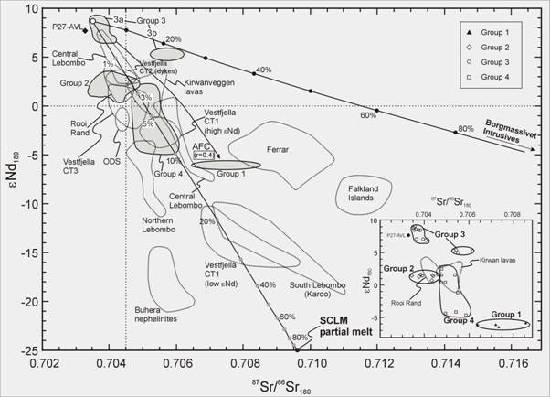
Figure 4: eNdi vs. 87Sr/86Sri for Karoo and Ferrar rock types from southern Africa and Antarctica
Group 3
Fifteen samples have been identified in the Group 3 magma type and they are characterized by low SiO2 (45.22 – 48.55 wt%), high TiO2 (3.25 – 4.85 wt%), high Ti/Y (291 – 777) and high MgO (7.63 – 21.61 wt%). Several of the samples can be classified as picrites, using the classification scheme of Le Bas (2000), and three samples are ferropicrites, following the broad criteria (FeO > MgO >12 wt%; Al2O3 < 10 wt%) used by Gibson et al. (2000). Harris et al. (1991) first identified the presence of picrites in western Dronning Maud Land and demonstrated that they were genuine high-MgO liquids. The ferropicrites are characterized by high contents of both MgO (12.00 – 13.45 wt%) and FeO (12.6 – 13.1 wt%), with mg-numbers in the range 63 – 65. The ferropicrites have low-moderate SiO2 contents (45.22 – 46.54 wt%), low Al2O3 (8.15 – 10.22 wt%) and low total alkalis (1.51 – 1.97 wt%). As would be anticipated given their high MgO contents, all Group 3 rocks have high concentrations of compatible trace elements: Cr (397 – 1006 ppm) and Ni (251 – 769 ppm), with the ferropicrites having the highest values (Cr: 683 – 1006 ppm; Ni: 578 – 619 ppm).
The REE patterns of Group 3 rocks are distinct from all other magma groups. They are characterized by ‘saddleback’ patterns (Fig. 3) with (La/Sm)N <1 and (La/Yb)N in the range 1.6 – 4.3 and a marked depletion in the HREE.
Group 3 samples also have distinct isotope signatures (Fig. 4) with generally depleted 87Sr/86Sri (0.7035 – 0.7062) and high eNdi (5.0 to 9.0). There appear to be two distinct sub-groups within Group 3, one with lower eNdi (5.0 – 5.5) and more radiogenic 87Sr/86Sri (0.7054 – 0.7062), whilst the other has higher eNdi (7.0 – 9.0) and less radiogenic 87Sr/86Sri (0.7035 – 0.7041). The three ferropicrites all fall into the high-eNd, low- 87Sr/86Sr sub-group. The Sr-Nd isotope compositions of the more unradiogenic Sr sub-group compare closely with that of a single sample from Vestfjella (P27-AVL; Luttinen & Furnes, 2000), which was previously identified as the most ‘depleted’ rock type from the entire Karoo (South Africa and Antarctica) province.
Group 4
Nine samples from the Ahlmannryggen are identified as Group 4. Their defining characteristic is their very high TiO2 (3.87 – 5.28 wt%), high Zr (343 – 568 ppm) and very high Ti/Y (664 – 694). Five of the group are picrites, with MgO >12 wt% and Na2O + K2O <3 wt% and are characterized by high Cr (834 – 965 ppm) and Ni (666 – 885 ppm) contents. The REE patterns are the most enriched of the four geochemical groups with (La/Yb)N values of 7.2 – 19.3 and La contents 81 – 204 times chondrite (Fig. 3). Samples from Group 4 show a range in 87Sr/86Sri of 0.7048 – 0.7059, and eNdi varies considerably from -4.6 to 2.4 (Fig. 4).
Comparision to other Karoo magma groups
The Mesozoic intrusions of the Ahlmannryggen overlap with the main phase of volcanic and intrusive activity of the Karoo magmatic province of southern Africa and East Antarctica. Geochemical data from East Antarctica (Kirwanveggen and Vestfjella: Fig. 1) and southern Africa are plotted in Fig. 2 (Zr vs. TiO2 plots for (a) Antarctica and (b) South Africa). Figure 2a also includes the four geochemical groups of the Ahlmannryggen dykes for comparison.
Data for the lavas of Vestfjella and the Kirwanveggen (Fig. 2a) form a much more restricted range relative to the Ahlmannryggen intrusions. The majority of the Vestfjella – Kirwanveggen samples fall into a low TiO2 (<2 wt%) and Zr <200 ppm group. One group of Vestfjella lavas, CT2 of Luttinen et al. (1998), has higher TiO2 (2.4 – 3.8 wt%), but these still have low Zr (<200 ppm).
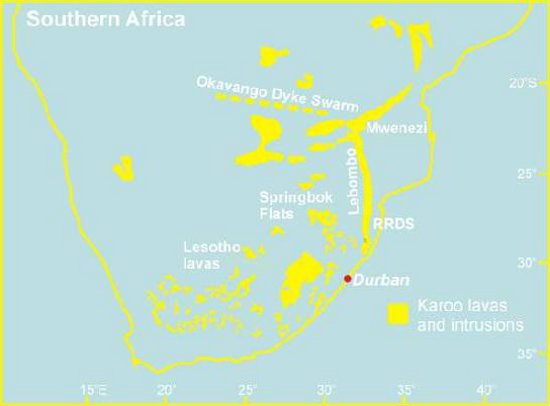
Figure 5: Geological extent of the Karoo province in southern Aftica. The major lava units and sill complexes are highlighted, along with the Okavango dyke swarm and Rooi Rand dyke swarm (RRDS)
The Karoo (Fig. 5) data from South Africa (Fig. 2b) also form a cluster at very low TiO2 (< 1.5wt%) and Zr (<120 ppm), although a significant number of samples extend to higher TiO2 and Zr values. The high TiO2-Zr (HTZ) samples are from the HTZ (low Fe) and HTZ (high Fe) groups of Sweeney et al. (1994) from the central Lebombo, and the Letaba Formation picrites of the Lebombo (Duncan et al., 1984). The Rooi Rand dyke swarm (RRDS) forms a broad spread and overlaps with the Ahlmannryggen Group 2. Group 4 overlap, in part, with the HTZ (high Fe) field of Sweeney et al. (1994) from the Lebombo part of the Karoo Province (Fig. 2b).
Conclusions
Emplacement history and tectonics
Our new geochemical groupings, together with structural and stratigraphical observations and geochronology, allow us to reconstruct the emplacement history of the Mesozoic dykes of the central Ahlmannryggenn range. Available 40Ar/39Ar ages indicate that the picrites and ferropicrites of Group 3 are the oldest of the Mesozoic dyke suites, emplaced at ~ 190 Ma. Group 3 dykes trend ~N 70 E and are restricted to a narrow, ~8 km wide corridor. Group 4 and Group 2 dykes represent the youngest, with an age peak at ~178 Ma.
Dykes of Group 1 are sub-parallel to the Group 3 picrites and ferropicrites. Group 2 and Group 4 dykes are dominantly NNE-SSW striking. The parallel relationship between dykes from Groups 1 and 3 suggest that they were probably all emplaced in response to the same applied stress field, which based on our geochronology existed at ~190 Ma. Although, the exposures of Group 3 dykes did not yield data conducive for dyke swarm dilation estimates, limited data from Group 1 dykes suggests an approximately N-S dilation direction (004 – 184°), and, by association, a parallel oriented minimum principal stress. In contrast, the overwhelming majority of dykes in Groups 2 and 4 are almost exclusively N-S to NNE-SSW trending (Jutulstraumen parallel) and were emplaced in response to NW-SE (307 – 127°) oriented dilation (minimum principal stress).
A large number of dykes are present on the eastern flank of the Jutulstraumen ice stream, exposed at Straumsvola nunatak and in other nunataks within a 30 km radius (Harris & Grantham, 1993). Here two main dyke trends can be recognised, one NE-SW trending (Harris & Grantham, 1993), and a second more dominant trend of NNW-SSE, although no data regarding the relative or absolute chronology of these dykes is currently available, other than that some dykes postdate the Straumsvola nepheline syenite, which is dated between 180.9 ± 2.8 Ma (Grantham, 1996) and 178 ± 2 Ma (Grantham et al., 2001), nor are there any palaeostress or dilation direction data. It is possible that NE-SW oriented dykes in the Straumsvola area were emplaced synchronously with similarly oriented dykes in the Ahlmannryggen. If such a correlation is correct the emplacement of these dykes implies the existence of a regional NW-SE oriented minimum principal stress direction that was perpendicular to the crustal boundary between the Archean Grunehogna craton and the 1 Ga mobile belt of the Maudheim Province (Fig. 1 inset).
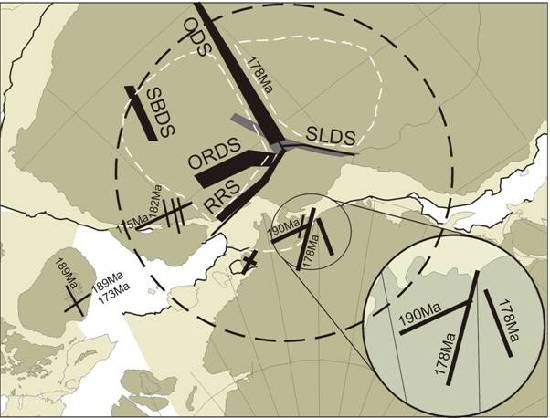
Figure 6: Radial dyke swarms of the Karoo volcanic province. RRS: Rooi Rand dyke swarm; SLDS: Sabie Limpopo dyke swarm; SBDS: South Botswana dyke swarm; ORDS: Olifants River dyke swarm; ODS: Okavango dyke swarm
The giant Okavango dyke swarm (ODS; Fig. 6) of southern Africa forms one arm of a giant radiating dyke swarm, which also includes the Sabie River (SRBF; Fig. 6) and Rooi Rand dyke swarms (RRDS; Fig. 6). Like the Group 2 and 4 dykes of the Ahlmannryggen, the Okavango dyke swarm exploits a major crustal boundary. This swarm has recently been dated and shown to contain a significant component of 178 Ma dykes (Elburg & Goldberg, 2000; Le Gall et al., 2003; Jourdan et al., 2004a). It therefore seems likely that the NNE-SSW oriented dykes of the Ahlmannryggen may have been a component of a similar radiating dyke swarm, although the small average width of the Ahlmannryggen dykes (~ 1 m), which is considerably less than the mean width of the Okavango dykes (18 m), suggest the potential Jutulstraumen arm of the radiating dyke swarm was subject to significantly reduced magmatism.
It is tempting to correlate the ENE-WSW trending dykes (Groups 1 and 3) of the Ahlmannryggen with the Rooi Rand dyke swarm (RRDS) of southern Africa, based on their sub-parallel alignment in Gondwana reconstructions (Fig. 6). However, both 40Ar/39Ar geochronology (RRDS is 173.9 ± 3.8 Ma; Jourdan et al., 2004b), and geochemistry suggests that the RRDS and Group 3 dykes were not emplaced as part of the same event.
Magma types
The minor intrusions of the Ahlmannryggen region of western Dronning Maud Land can be grouped into four distinct geochemical types (Groups 1 – 4) based on immobile incompatible elements (Ti, Zr, Y), LILE and Sr-Nd isotope composition. 40Ar/39Ar geochronology demonstrates two emplacement events at ~190 Ma (Groups 1 and 3) and ~178 Ma (Groups 2 and 4), which bracket the main Karoo volcanic event at ~182 Ma.
The Group 1 dykes were emplaced at ~190 Ma, parallel to the Group 3 dykes and to the Pencksökket subglacial trough, which may represent a major graben-like structure that extends to the southwest (Hungeling & Thyssen, 1991), parallel to the Heimefrontfjella (Fig. 1). The petrogenesis of the Group 1 dykes is uncertain. They could be generated by mixing of ~12% melt fraction of an enriched SCLM component with the partial melt of a depleted source. In this case the variation in 87Sr/86Sr at constant eNd might be the result of post-magmatic alteration. However, the variation in 87Sr/86Sr also correlates with SiO2 and mg-number and an alternative interpretation is that the Group 1 dykes are the result of AFC processes from a Group 3 parental magma involving lower Archean crust as the contaminant.
The Group 2 rocks show little or no chemical evidence of crustal contamination. However, trace element ratios and Nd-Sr isotopic data suggest the involvement of an enriched lithospheric mantle source component in their petrogenesis. If the primary mantle-derived magmas were similar in composition to the low-87Sr/86Sr Group 3 magmas then the Group 2 compositions could be generated by mixing of <10% melt fraction of an enriched SCLM component with a partial melt of a depleted source. The Group 2 rocks were intruded at ~178 Ma, broadly parallel to the Jutulstraumen subglacial trough, which is interpreted as a continental rift and may be continuous with the Pencksökket trough (Fig. 1). The Jutulstraumen rift has associated alkaline magmatism along it eastern margin (Harris & Grantham, 1993). Group 2 rocks are also geochemically similar to the Rooi Rand dykes of the Lebombo rift, which were also emplaced late in the history of the province.
The Group 3 rocks of the Ahlmannryggen form the most unusual geochemical group of the entire Karoo-Antarctic magmatic province. They include high Ti-Zr picrites and ferropicrites, which have isotopic characteristics (eNd ~9, 87Sr/86Sr ~0.7035) consistent with derivation from a depleted mantle source. Their high TiO2 and Zr contents and MORB-normalised trace element patterns suggest they are derived by small degrees of partial melts of a MORB-like source. The Group 3 dykes were intruded at ~190 Ma, parallel to the Pencksökket glacial trough and represent the first magmas of the Karoo-Antarctic province. They show evidence, in part, of both enriched mantle and crustal contamination. A subgroup at less depleted isotope values (eNd ~5, 87Sr/86Sr ~0.7055) is considered to be the result of ~10% upper crustal contamination, whilst a secondary subgroup (Fig. 4) is the product of small amounts of mixing with partial melts of enriched lithospheric mantle. The ‘uncontaminated’ Group 3 (eNd ~9; 87Sr/86Sr ~0.7035) samples are considered to represent the closest composition to the primitive sub-lithopsheric magmas in the Ahlmannryggen.
The rocks of Group 4 are high Ti-Zr, low-K picrites, which overlap, in part, with the high Ti-Zr basalts of the central Lebombo (Sweeney et al., 1994) and the high-Ti CT4 Group from Vestfjella (Luttinen et al., 1998). They were intruded at ~177 – 178 Ma and extend from the Ahlmannryggen to the southern Kirwanveggen (Fig. 1). They have a strike direction parallel to the Jutulstraumen glacial trough and to the 178 Ma Group 2 intrusions. They appear to be small-volume partial melts generated at depths similar to, or greater than the Group 3 magmas. The Group 4 rocks fall into two subtypes; those with a clear contribution from subduction-modified lithospheric mantle (strongly negative eNd, Nb-Ta negative anomaly) and those with positive eNd and flatter multi-element patterns. Sweeney et al. (1994) suggested a key role for subcontinental lithospheric mantle and an asthenospheric plume in the generation of the Lebombo low-K picrites.
Role of a mantle plume
The geochemical characteristics of the Ahlmannryggen intrusions suggest complex mixing relationships between Ti-rich, small volume partial melts (Group 3) of a depleted mantle source and partial melts of enriched lithospheric mantle plus assimilation of local continental crust. The isotopically depleted end-member has both MORB- and OIB-like characteristics. It is tempting to invoke an asthenospheric mantle plume origin for the Group 3 magmas and given their intrusion age (~190 Ma) this lends support to the incubating asthenospheric plume model of Sweeney et al. (1994).
Where mantle plumes have been interpreted as being responsible for the magmatism of flood basalt provinces there is often continued debate as to whether the plume arrival at the base of the lithosphere and large volume melting occurred during a short time period (a few Myr) or whether plume arrival was then followed by a prolonged period (~10 Myr) prior to the main episode of magmatism.
40Ar/39Ar geochronology by Duncan et al. (1997) on basic lavas from southern Africa and the Kirwanveggen suggest that the duration of magmatism was very short (1 –2 Myr). However the Duncan et al. (1997) study did not include any data on minor intrusions of the Karoo. The new 40Ar/39Ar geochronology data presented here indicate a long-lived magmatic event of greater than 10 Myr, (178 – 190 Ma). This extended time period is associated with diverse magma chemistry, in contrast to the dominantly low-Ti tholeiites associated with the 182 – 183 Ma flood basalt event. The style and chronology of the magmatism observed in the Karoo – Dronning Maud Land is akin to that described from the Etendeka province of NW Namibia (Thompson et al., 2001), although the Karoo event is considerably more prolonged and is associated with craton boundaries. The evidence presented here strongly suggests a plume incubation model may be applicable for the Early Jurassic magmatism of the Karro – Dronning Maud Land province.
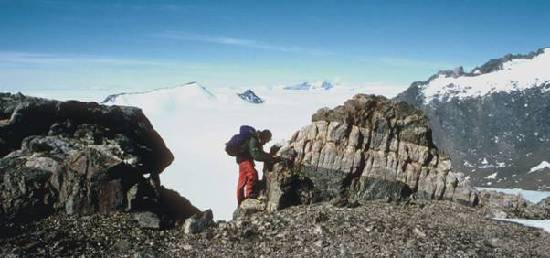
References
Armstrong, R. A., Bristow, J. W. & Cox, K. G. (1984). The Rooi Rand dyke swarm, southern Lebombo. In: Erlank, A. J. (ed.) Petrogenesis of the Volcanic Rocks of the Karoo Province. Johannesburg: Geological Society of South Africa, Special Publications 13, 77–86.
Bergman, S. C. (1987). Lamproites and other potassium-rich igneous rocks: a review of their occurrence, mineralogy and geochemistry. In Fitton, J. G. & Upton, B. G. J., eds. Alkaline Igneous Rocks. Geological Society of London Special Publication, No. 30, 103-190.
Brewer, T. S., Rex, D., Guise, P. G. & Hawkesworth, C. J. (1996). Geochronology of Mesozoic tholeiitic magmatism in Antarctica: implications for the development of the failed Weddell Sea rift system. In: Storey, B. C., King, E. C. & Livermore, R. A. (eds.) Weddell Sea Tectonics and Gondwana Break-up. Geological Society, London, Special Publications 108, 45–61.
Bussell, M. A. (1989). A simple method for the determination of the dilation direction of intrusive sheets. Journal of Structural Geology 11, 679-687.
Chambers, L. M. & Fitton, J. G. (2000). Geochemical transitions in the ancestral Iceland plume: evidence from the Isle of Mull Tertiary volcano, Scotland. Journal of the Geological Society, London 157, 261- 263.
Cox, K. G. (1989). The role of mantle plumes in the development of continental drainage patterns. Nature 342, 873-877.
Cox, K. G. (1992). Karoo igneous activity, and the early stages of the break-up of Gondwnanaland. In: Storey, B. C., Alabaster, T. & Pankhurst, R. J. (eds) Magmatism and the Causes of Continental Break-up. Geological Society, London, Special Publications 68, 137–148.
Curtis, M. L. & Riley, T. R. (2003). Mobilization of fluidised sediment during sill emplacement, western Dronning Maud Land, East Antarctica. Antarctic Science 15, 393-398.
De Bruiyn, H., Schoch, A.E., van der Westhuizen, W.A. & Myburgh, C.A. (2000). Picrite from the Katse area, Lesotho: evidence for flow differentiation. Journal of African Earth Sciences, 31, 657- 668.
Delaney, P. T., Pollard, D. D., Ziony, J. I. & McKee, E. H. (1986). Field relations between dikes and joints: emplacement processes and palaeostress analysis. Journal of Geophysical Research 91, 4920- 4938.
Duncan, A. R., Erlank, A. J. & Marsh, J. S. (1984). Geochemistry of the Karoo igneous province. In: Erlank, A. J. (ed.) Petrogenesis of the Volcanic Rocks of the Karoo Province. Johannesburg: Geological Society of South Africa, Special Publications 13, 355–388.
Duncan, A. R., Armstrong, R. A., Erlank, A. J., Marsh, J. S. & Watkins, R. T. (1990). MORB-related dolerites associated with the final phases of Karoo flood basalt volcanism in southern Africa. In: Parker, A. J., Rickwood, P. C. & Tucker, D. H. (eds.) Mafic Dykes and Emplacement Mechanisms. Rotterdam: Balkema, 119–129.
Duncan, R. A., Hooper, P. R., Rehacek, J., Marsh, J. S. & Duncan, A. R. (1997). The timing and duration of the Karoo igneous event, southern Gondwana. Journal of Geophysical Research 102, 18127–18138.
Elburg, M. & Goldberg, A. (2000). Age and geochemistry of Karoo dolerite dykes form northeast Botswana. Journal of African Earth Sciences 31, 539-554.
Ellam, R. M. & Cox, K. G. (1991). An interpretation of Karoo picrite basalts in terms of interaction between asthenospheric magmas and the mantle lithosphere. Earth and Planetary Science Letters 105, 330–342.
Ellam, R. M., Carlson, R. W. & Shirley, S. B. (1992). Evidence from Re–Os isotopes for plume–lithosphere mixing in Karoo flood basalt genesis. Nature 359, 718–721.
Elliot, D. H., Fleming, T. H., Kyle, P. R. & Foland, K. A. (1999). Long-distance transportation of magmas in the Jurassic Ferrar Large Igneous Province, Antarctica. Earth and Planetary Science Letters 167, 89–104.
Erlank, A. J. (1984). Petrogenesis of the Volcanic Rocks of the Karoo Province. Johannesburg: Geological Society of South Africa, Special Publications 13.
Ernst, R. E. & Buchan, K. L. (2001). The use of mafic dyke swarms in identifying and locating mantle plumes. In: Ernst, R. E. & Buchan, K. L. (eds.) Mantle Plumes: Their identification through time. Boulder, Colorado: Geological Society of America Special Paper 352, 247-265.
Ewart, A., Marsh, J. S., Milner, S. C., Duncan, A. R., Kamber, B. S. & Armstrong, R. A. (2004). Petrology and geochemistry of Early Cretaceous bimodal continental flood volcanism of the NW Etendeka, Namibia. Part 1: Introduction, mafic lavas and re-evaluation of mantle source components. Journal of Petrology, 45, 59-105.
Fitton, J. G., Saunders, A. D., Norry, M. J., Hardarson, B. S. & Taylor, R. N. (1997). Thermal and chemical structure of the Iceland plume. Earth and Planetary Science Letters 153, 197-208.
Fitton, J. G., Saunders, A. D., Kempton, P. D. & Hardarson, B. S. (2003). Does depleted mantle form an intrinsic part of the Iceland plume? Geochemistry, Geophysics, Geosystems 4, 1029/2002GC000424.
Fleming, T. H., Foland, K. A. & Elliot, D. H. (1995). Isotopic and chemical constraints on the crustal evolution and source signature of Ferrar magmas, north Victoria Land, Antarctica. Contributions to Mineralogy and Petrology 121, 217–236.
Floyd, P. A. (1985). Petrology and geochemistry of intraplate sheet- flow basalts, Nauru Basin, Deep Sea Drilling Project leg 89. In: Moberley, R. & Schlanger, S. O. (eds.) Initial Reports of the Deep Sea Drilling Project, 89, 471-497.
Foulger, G. R. (2002). Plumes, or plate tectonic processes? Astronomy and Geophysics 43, 6.19-6.23.
Furnes, H., Neumann, E.-R. & Sundvoll, B. (1982). Petrology and geochemistry of Jurassic basalt dikes from Vestfjella, Dronning Maud Land, Antarctica. Lithos 15, 295–304.
Furnes, H., Vad, E., Austrheim, H., Mitchell, J. G. & Garmann, L. B. (1987). Geochemistry of basalt lavas from Vestfjella and adjacent areas, Dronning Maud Land, Antarctica. Lithos 20, 337–356.
Gibson, S. A., Thompson, R. N. & Dickin, A. P. (2000). Ferropicrites: geochemical evidence for Fe-rich streaks in upwelling mante plumes. Earth and Planetary Science Letters 174, 355-374.
Grantham, G. H. (1996). Aspects of Jurassic magmatism and faulting in western Dronning Maud Land, Antarctica: implications for Gondwana break-up. In: Storey, B. C., King, E. C. & Livermore, R. A. (eds.) Weddell Sea Tectonics and Gondwana Break-up. Geological Society, London, Special Publications 108, 63–73.
Grantham, G. H. & Hunter, D. R. (1991). The timing and nature of faulting and jointing adjacent to the Pencksökket, western Dronning Maud Land, Antarctica. In: Thomson, M. R. A., Crame, J. A. & Thomson, J. W. (eds.) Geological Evolution of Antarctica. Cambridge: Cambridge University Press, 47–51.
Grantham, G. H., Guise, P. G., Spell, T., Eglington, B. M. & Kruger, F. J. (2001). The age, chemistry and structure of Jurassic intrusions in H.U. Svedrupfjella, western Dronning Maud Land. International Dyke Conference, Ithala, South Africa, 27 (abstract).
Groenewald, P. M., Moyes, A. B., Grantham, G. H. & Krynauw, J. R. (1995). East Antarctic crustal evolution: geological constraints and modelling in western Dronning Maud Land. Precambrian Research 75, 231–250.
Hanson, R. E., Martin, M. W., Bowring, S. A. & Munyanyiwa, H. (1998). U-Pb zircon age for the Umkondo dolerites, eastern Zimbabwe: 1.1 Ga large igneous province in southern Africa – East Antarctica and possible Rodinia correlations. Geology 26, 1143-1146.
Harris, C. & Grantham, G. H. (1993). Geology and petrogenesis of the Straumsvola nepheline syenite complex, Dronning Maud Land, Antarctica. Geological Magazine 130, 513–532.
Harris, C., Marsh, J. S., Duncan, A. R. & Erlank, A. J. (1990). The petrogenesis of the Kirwan Basalts of Dronning Maud Land, Antarctica. Journal of Petrology 31, 341–369.
Harris, C., Watters, B. R. & Groenewald, P. B. (1991). Geochemistry of the Mesozoic regional basic dykes of western Dronning Maud Land, Antarctica. Contributions to Mineralogy and Petrology 107, 100–111.
Harris, C., Johnstone W. P. & et Phillips, D. (2002). Petrogenesis of the Mesozoic Sistefjell syenite intrusion, Dronning Maud Land, Antarctica and surrounding low-d18O lavas. South African Journal of Geology 105, 205-226.
Harmer, R. E., Lee, C. A. & Eglington, B. M. (1998). A deep mantle source for carbonatite magmatism: evidence from the nephelinites and carbonatites of the Buhera district, SE Zimbabwe. Earth and Planetary Science Letters, 158, 131-142.
Hawkesworth, C. J., Kelley, S. P., Turner, S., le Roex, A. P. & Storey, B. C. (1999). Mantle processes during Gondwana break-up and dispersal. Journal of African Earth Sciences 28, 239-261.
Hergt, J. M., Peate, D. W. & Hawkesworth, C. J. (1991). The petrogenesis of Mesozoic Gondwana low-Ti flood basalts. Earth and Planetary Science Letters 105, 134–148.
Hofmann, A. W. (1988). Chemical differentation of the Earth: the relationship between mantle, continental crust and oceanic crust. Earth and Planetary Science Letters, 90, 297-314.
Hungeling, A. & Thyssen, F. (1991). Reflection seismic measurements in western Neuschwabenland. In: Thomson, M. R. A., Crame, J. A. & Thomson, J. W. (eds) Geological Evolution of Antarctica. Cambridge: Cambridge University Press, pp. 549–555.
Jacobs, J., Thomas, R. J. & Weber, K. (1993). Accretion and indentation tectonics at the southern edge of the Kaapvaal craton during Kibaran (Grenville) orogeny. Geology 21, 203–206.
Jourdan, F., Féraud, G., Bertrand, H., Kampunzu, A. B., Tshoso, G., Le Gall, B., Tiercelin, J. J. & Capiez, P. (2004a). The Karoo triple junction questioned: evidence from Jurassic and Proterozoic 40Ar/39Ar ages and geochemistry of the Okavango dyke swarm (Botswana). Earth and Planetary Science Letters 222, 989- 1006.
Jourdan, F., Féraud, G., Bertrand, H., Kampunzu, Watkeys, M. K., Le Gall, B. & Tshoso, G. (2004b). New age constraints on the Karoo large igneous province: Triple junction and brevity questioned. Goldschmidt Geochemistry Conference, Copenhagen, Program with abstracts, A575.
Kent, R. W. & Fitton, J. G. (2000). Mantle sources and melting dynamics in the British Palaeogene igneous province. Journal of Petrology 41, 1023-1040.
Kerr, A. C., Saunders, A. D., Tarney, J., Berry, N. H. & Hards, V. L. (1995). Depleted mantle-plume geochemical signatures: no paradox for plume theories. Geology 23, 843-846.
Koppers, A. A. P. (2002). ArArCALC - software for Ar-40/Ar-39 age calculations. Computers and Geosciences 28, 605-619.
Kretz, R. (1991). The dilation direction of intrusive sheets. Journal of Structural Geology 13, 97-99.
Krynauw, J. R., Hunter, D. R. & Wilson, A. H. (1988). Emplacement of sills into wet sediments at Grunehogna, western Dronning Maud Land, Antarctica. Journal of the Geological Society, London 145, 1019 -1032.
Le Bas, M. J. (2000). IUGS reclassification of the high-Mg and picritic volcanic rocks. Journal of Petrology 41, 1467-1470.
Le Bas, M. J., Le Maitre, R. W., Streckeisen, A. & Zanettin, B. (1986). A chemical classification of volcanic rocks based on the total alkali–silica diagram. Journal of Petrology 27, 745–750.
Le Gall, B., Tshoso, G., Jourdan, F., Féraud, G., Bertrand, H., Tiercelin, J. J., Kampunzu, A. B., Modisi, M. P., Dyment, J. & Maia, M. (2002). 40Ar/39Ar geochronology and structural data from the giant Okavango and related mafic dyke swarms, Karoo igneous province, northern Botswana. Earth and Planetary Science Letters 202, 595 -606.
le Roex, A. P. & Lanyon, R. (1998). Isotope and trace element geochemistry of Cretaceous Damaraland lamprophyres and carbonatites, northwestern Namibia: evidence for plume-lithosphere interactions. Journal of Petrology 39, 1117-1146.
Luttinen, A. V., Rämö, O. T. & Huhma, H. (1998). Nd and Sr isotopic and trace element composition of a Mesozoic CFB suite from Dronning Maud Land, Antarctica: implications for lithosphere and asthenosphere contributions to Karoo magmatism. Geochimica et Cosmochimica Acta 62, 2701–2714.
Luttinen, A. V. & Furnes, H. (2000). Flood basalts of Vestfjella: Jurassic magmatism across an Archaean – Proterozoic lithospheric boundary in Dronning Maud Land, Antarctica. Journal of Petrology 41, 1271-1305.
Marsh, J. S. & Mndaweni, M. J. (1998). Geochemical variations in a long Karoo dyke, eastern Cape. South African Journal of Geology 101, 119-122.
Mitchell, A. A., Rmaluckan, V. R., Dunlevey, J. N. & Eglington, B. M. (1996). The basalt stratigraphy of the Sani Pass, Kwazulu/Natal Drankensberg. South African Journal of Geology 99, 251-262.
Mitchell, C., Ellam, R. M. & Cox, K. G. (1999). Mesozoic dolerite dykes of the Falkland Islands: petrology, petrogenesis and implications for geochemical proivinciality in Gondwanaland low-Ti basaltic rocks. Journal of the Geological Society, London 156, 901-916.
Molzahn, M., Reisberg, L. & Wörner, G. (1996). Os, Sr, Nd, Pb and O isotope and trace element data from the Ferrar flood basalts, Antarctica: evidence for an enriched subcontinental lithospheric source. Earth and Planetary Science Letters, 144, 529-546.
Moyes, A. B., Krynauw, J. R. & Barton, J. M. (1995). The age of the Ritscherflya Supergroup and Borgmassivet Intrusions, Dronning Maud Land, Antarctica. Antarctic Science 7, 87-97.
Nakamura, N. (1974). Determination of REE, Ba, Fe, Mg, Na and K in carbonaceous and ordinary chondrites. Geochimica et Cosmochimica Acta 38, 757-773.
Ottley, C. J., Pearson, D. G & Irvine, G. J. (in press). A routine method for the dissolution of geological samples for the analysis of REE and trace elements via ICP-MS.
Pankhurst, R. J. & Rapela, C. R. (1995). Production of Jurassic rhyolites by anatexis of the lower crust of Patagonia. Earth and Planetary Science Letters, 134, 23-36.
Peate, D.W. (1997). The Paraná-Etendeka Province. In: J. Mahoney & M. Coffin (eds), Large Igneous Provinces: Continental, Oceanic, and Planetary Flood Volcanism,
AGU Geophysical Monograph 100, 217-245.
Peters, M., Haverkamp, B., Emmermann, R., Kohnen, H. & Weber, K. (1991). Palaeomagnetism, K–Ar dating and geodynamic setting of igneous rocks in western and central Neuschwabenland, Antarctica. In: Thomson, M. R. A., Crame, J. A. & Thomson, J. W. (eds) Geological Evolution of Antarctica. Cambridge: Cambridge University Press, pp. 549–555.
Reid, D. L., Rex, D. C. & Brandl, G. (1997). Karoo basalts in the Ellisras sub-basin, northern Province. South African Journal of Geology 100, 151-156.
Renne, P. R., Swisher, C. C., Deino, A. L., Karner, D. B., Owens, T. L. & DePaolo, D. J. (1998). Intercalibration of standards, absolute ages and uncertainties in Ar-Ar dating. Chemical Geology, 145, 117- 152.
Riley, T. R. & Knight, K. B. (2001). Age of pre-break-up Gondwana magmatism: a review. Antarctic Science 13, 99-110. Download pdf here.
Riley, T. R., Millar, I. L., Watkeys, M. K., Curtis, M. L., Leat, P. T., Klausen, M. B. & Fanning C. M. (2004). U-Pb zircon (SHRIMP) ages for the Lebombo rhyolites, South Africa: refining the duration of Karoo volcanism. Journal of the Geological Society, London 161, 542-545. Download pdf here.
Riley, T. R., Leat, P. T., Curtis, M. L., Millar, L. L. & Fazel., A. (2005). Early-Middle Jurassic dolerite dykes from western Dronning Maud Land (Antarctica): identifying mantle sources in the Karoo large igneous province. Journal of Petrology 46, 1489-1524. Download pdf here.
Rock, N. M. S. (1991). Lamprophyres. Glasgow: Blackie.
Rollinson, H. (1993). Using geochemical data: evaluation, presentation, interpretation. Longman scientific, 352 pp.
Rudnick, R. L. & Fountain, D. M. (1995). Nature and composition of the continental crust: a lower crustal perspective. Reviews of Geophysics 33, 267–309.
Sun, S. S. & McDonough, W. F. (1989. Chemical and isotopic systematics of oceanic basalts: implications for mantle composition and processes. In: Saunders, A. D. & Norry, M. J. (eds.) Magmatism in Ocean Basins. Geological Society, London, Special Publications 42, 313–345.
Sweeney, R. J., Duncan, A. R. & Erlank, A. J. (1994). Geochemistry and petrogenesis of Central Lebombo basalts of the Karoo Igneous Province. Journal of Petrology 35, 95–125.
Thompson, R. N., Gibson, S. A., Dickin, A. P. & Smith, P. M. (2001). Early Cretaceous basalt and picrite dykes of the southern Etendeka region, NW Namibia: windows into the role of the Tristan mantle plume in Paraná – Etendeka magmatism. Journal of Petrology 42, 2049-2081.
Vuori, S. K. & Luttinen, A.V. (2003). The Jurassic gabbroic intrusions of Utpostane and Muren: Insights into Karoo-related plutonism in Dronning Maud Land, Antarctica. Antarctic Science 15, 283- 301.
Wolmarans, L. G. & Kent, L. E. 1982. Geological investigations in western Dronning Maud Land, Antarctica - a synthesis. South African Journal of Antarctic Research supplement 2.
Wooden, J. L., Czamanske, G. K., Federenko, V. A., Arndt, N. T., Chauvel, C., Bouse, R. M., King, B. W., Knight, R. J. & Siems, D. F. (1993). Isotopic and trace element constraints on mantle and crustal contributions to Siberian continental flood basalts, Noril’sk area, Siberia. Geochimica et Cosmochimica Acta 57, 3677-3704.
Yoder, H. S. & Tilley, C. E. (1962). Origin of basalt magmas: an experimental study of natural and synthetic rock systems. Journal of Petrology 3, 342–532.
Zhang, X., Luttinen, A. V., Elliot, D. H., Larsson, K. & Foland, K. A. (2003). Early stages of Gondwana breakup: The 40Ar/39Ar geochronology of Jurassic basaltic rocks from western Dronning Maud Land, Antarctica, and implications for the timing of magmatic and hydrothermal events. Journal of Geophysical Research 108, 2249.
